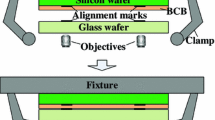Abstract
In semiconductor manufacturing process, the wafer direct bonding, so-called die-to-wafer hybrid bonding, still has unexpected voids on the boning surface which decreases the bonding efficiency. Therefore, this paper proposes a design approach for the bonding head guiding platform (BHGP) based on compliant mechanism for the die-to-wafer hybrid bonding. Firstly, a bridge amplification module (BAM) is designed and simulated. Secondly, a dual parallelogram module (DPM) is designed and analyzed. Then, the BAM is combined with the DPM to create a full design of the BHGP. To investigate the parametric effect of the geometric inputs on the output behaviors of the platform, the parameter sensitivity is conducted. The multi-objective optimization study is performed using multi-objective genetic algorithm. The results determined the displacement can gain up to 191.88 μm, the parasitic error has a small value of 1.47 μm, and the von Mises stress is minimal value of 52 MPa. The crosstalk of the platform is about 3.82%, and this ratio ensures a linear characteristic of the platform. A small value of stress allows a high safety factor during operation. The result of this study is expected be utilized for removing voids in the die-to-wafer hybrid bonding process.
















Similar content being viewed by others
References
Gao, G., Workman, T., Uzoh, C., Bang, K.M., Mirkarimi, L., Theil, J., Suwito, D., Katkar, R., Fountain, G., Guevara, G., Lee, B.: Die to wafer stacking with low temperature hybrid bonding. In: Proceedings of the Electronic Components and Technology Conference 2020 June, 589–594 (2020). https://doi.org/10.1109/ECTC32862.2020.00098
Bourjot, E., Stewart, P., Dubarry, C., Lagoutte, E., Rolland, E., Bresson, N., Romano, G., Scevola, D., Balan, V., Dechamp, J., Zussy, M., Mauguen, G., Castan, C., Sanchez, L., Jouve, A., Fournel, F., Cheramy, S.: Towards a complete direct hybrid bonding D2W integration flow: known-good-dies and die planarization modules development. In: 2019 International 3D Systems Integration Conference (2019). https://doi.org/10.1109/3DIC48104.2019.9058783
Sanchez, L., Bally, L., Montmayeul, B., Fournel, F., Dafonseca, J., Augendre, E., Di Cioccio, L., Carron, V., Signamarcheix, T., Taibi, R., Mermoz, S., Lecarpentier, G.: Chip to wafer direct bonding technologies for high density 3D integration. In: Proceedings of the Electronic Components and Technology Conference, 1960–1964 (2012). https://doi.org/10.1109/ECTC.2012.6249108
Katti, G., Mercha, A., Van Olmen, J., Huyghebaert, C., Jourdain, A., Stucchi, M., Rakowski, M., Debusschere, I., Soussan, P., Dehaene, W., De Meyer, K., Travaly, Y., Beyne, E., Biesemans, S., Swinnen, B.: 3D stacked ICs using Cu TSVs and die to wafer hybrid collective bonding. In: 2009 IEEE International Electron Devices Meeting (IEDM), 357–360 (2009). https://doi.org/10.1109/IEDM.2009.5424351
Gao, G., Mirkarimi, L., Workman, T., Guevara, G., Theil, J., Uzoh, C., Fountain, G., Lee, B., Mrozek, P., Huynh, M., Katkar, R.: Development of low temperature direct bond interconnect technology for die-to-wafer and die-to-die applications-stacking, yield improvement, reliability assessment. In: 2018 International Wafer Level Packaging Conference (IWLPC), 2018, 1–7 (2018). https://doi.org/10.23919/IWLPC.2018.8573278
Amandine, J., Sanchez, L., Castan, C., Laugier, M., Rolland, E., Montmayeul, B., Franiatte, R., Fournel, F., Cheramy, S.: Self-assembly process for 3D die-to-wafer using direct bonding: a step forward toward process automatisation. In: Proceedings of the Electronic Components and Technology Conference 2019-May, 225–234 (2019). https://doi.org/10.1109/ECTC.2019.00041
Fukushima, T., Iwata, E., Bea, J., Murugesan, M., Lee, K.W., Tanaka, T., Koyanagi, M.: Evaluation of alignment accuracy on chip-to-wafer self-assembly and mechanism on the direct chip bonding at room temperature. In: 2010 IEEE International 3D Systems Integration Conference (3DIC), 3DIC, (2010). https://doi.org/10.1109/3DIC.2010.5751436
Ding, B., Li, Y., Xiao, X., Tang, Y., Li, B.: Design and analysis of a 3-DOF planar micromanipulation stage with large rotational displacement for micromanipulation system. Mech. Sci. (2017). https://doi.org/10.5194/ms-8-117-2017
Gui, S., Zhang, S., Fu, B., Ling, M.: Fluid-dynamic analysis and multi-objective design optimization of piezoelectric servo valves. Flow Meas. Instrum. (2022). https://doi.org/10.1016/j.flowmeasinst.2022.102157
Ding, B., Zhao, J., Li, Y.: Design of a spatial constant-force end-effector for polishing/deburring operations. Int. J. Adv. Manuf. Technol. 116, 3507–3515 (2021)
Dang, M.P., Dao, T.-P., Chau, N.L., Le, H.G.: Effective hybrid algorithm of taguchi method, fem, RSM, and teaching learning-based optimization for multiobjective optimization design of a compliant rotary positioning stage for nanoindentation tester. Math. Probl. Eng. (2019). https://doi.org/10.1155/2019/4191924
Chau, N.L., Tran, N.T., Dao, T.P.: Design optimization for a compliant mechanism based on computational intelligence method. Neural Comput. Appl. (2021). https://doi.org/10.1007/s00521-021-05717-0
Chen, F., Zhang, Q., Gao, Y., Dong, W.: A review on the flexure-based displacement amplification mechanisms. IEEE Access. 8, 205919–205937 (2020). https://doi.org/10.1109/ACCESS.2020.3037827
Ling, M., Cao, J., Jiang, Z., Zeng, M., Li, Q.: Optimal design of a piezo-actuated 2-DOF millimeter-range monolithic flexure mechanism with a pseudo-static model. Mech. Syst. Signal Process. 115, 120–131 (2019). https://doi.org/10.1016/j.ymssp.2018.05.064
Qin, Y.D., Zhao, X., Shirinzadeh, B., Tian, Y.L., Zhang, D.W.: Closed-form modeling and analysis of an XY flexure-based nano-manipulator. Chin. J. Mech. Eng. (2018). https://doi.org/10.1186/s10033-018-0211-z
Ling, M., Cao, J., Zeng, M., Lin, J., Inman, D.J.: Enhanced mathematical modeling of the displacement amplification ratio for piezoelectric compliant mechanisms. Smart Mater. Struct. (2016). https://doi.org/10.1088/0964-1726/25/7/075022
Castillo, O., Trujillo, L., Melin, P.: Multiple objective genetic algorithms for path-planning optimization in autonomous mobile robots. Soft Comput. 11, 269–279 (2007). https://doi.org/10.1007/s00500-006-0068-4
Acknowledgements
This research is supported by Industrial University of Ho Chi Minh City (IUH) under grant number 01/HD-DHCN.
Author information
Authors and Affiliations
Corresponding author
Additional information
Publisher's Note
Springer Nature remains neutral with regard to jurisdictional claims in published maps and institutional affiliations.
Rights and permissions
Springer Nature or its licensor holds exclusive rights to this article under a publishing agreement with the author(s) or other rightsholder(s); author self-archiving of the accepted manuscript version of this article is solely governed by the terms of such publishing agreement and applicable law.
About this article
Cite this article
Nguyen, D.N., Dang, M.P., Dixit, S. et al. A design approach of bonding head guiding platform for die to wafer hybrid bonding application using compliant mechanism. Int J Interact Des Manuf 17, 2855–2866 (2023). https://doi.org/10.1007/s12008-022-01019-4
Received:
Accepted:
Published:
Issue Date:
DOI: https://doi.org/10.1007/s12008-022-01019-4




